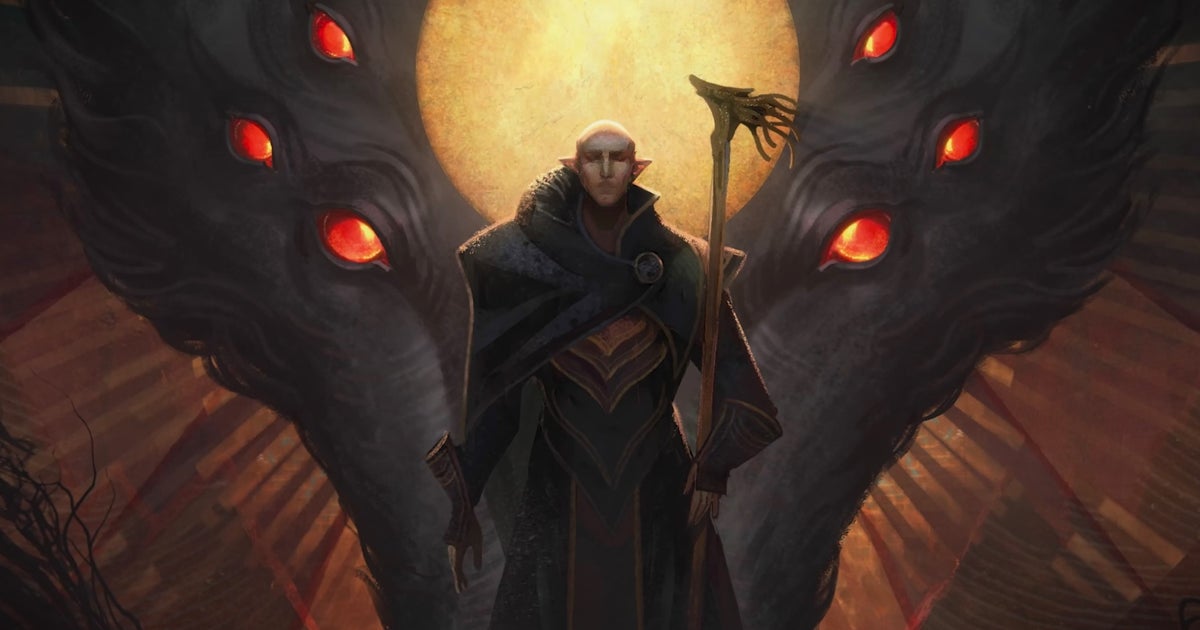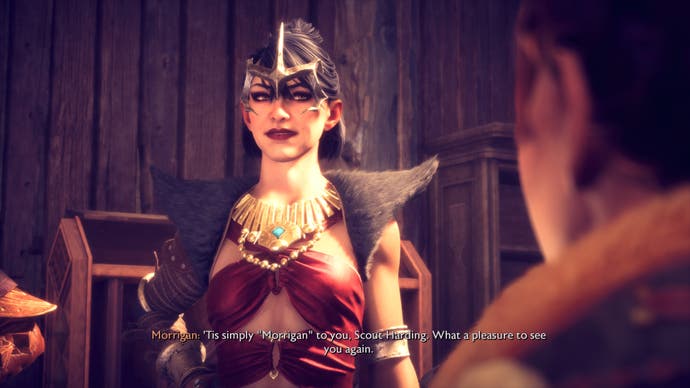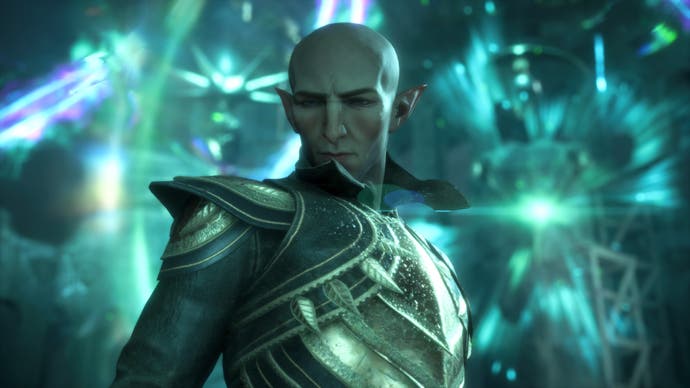
- Action Adventure
- BioWare
- Bird view / Isometric
- Dragon Age II
- Dragon Age: Inquisition
- Dragon Age: Origins
- Dragon Age: The Veilguard
- Electronic Arts
- Multiplayer Competitive
- Multiplayer Cooperative
- PC
- ps3
- ps4
- rpg
- Single Player
- Strategy
- Third person
- Xbox 360
- xbox one
BioWare knew the deepest secrets of Dragon Age lore 20 years ago, and locked it away in an uber-plot doc
As I write about the secrets hidden in Dragon Age’s mysterious Fade, and as I uncover some of them playing Dragon Age: The Veilguard, one question keeps rising up in my mind.
How much did BioWare know about future events when first developing the series more than 20 years ago? That’s a long time, and back then BioWare didn’t know there would be a second game, which is why Dragon Age: Origins has an elaborate and far-reaching epilogue. Why lay so much lore-track ahead of yourself if you don’t think you’ll ever get there?
But look more closely at Origins and there are big clues suggesting BioWare did know about future Dragon Age events. There are obvious signs in the original game, such as establishing recurring themes like Old Gods and the Blight and Archdemons. But there’s also Flemeth, Morrigan’s witchy mother, who’s intimately linked to events in the series now – more specifically: intimately linked to Solas. Does her existence mean Solas was known about back then too?
There’s only one person I can think of to answer this and it’s David Gaider, the original creator of Dragon Age’s world and lore. We’ve talked before, once in a podcast and once for a piece on the magic of fantasy maps, where we discussed the creation of Dragon Age’s world. And much to my surprise, when I ask him what he and the BioWare team knew back then, he says they knew it all.
“By the time we released Dragon Age: Origins, we were basically sure that it was one and done, but there was, back when we made the world, an overarching plan,” he says. “The way I created the world was to seed plots in various parts of the world that could be part of a game, a single game, and then there was the overall uber-plot, which I didn’t know for certain that we would ever get to but I had an understanding of how it all worked together.
“A lot of that was in my head until we were starting Inquisition and the writers got a little bit impatient with my memory or lack thereof, so they pinned me down and dragged the uber-plot out of me. I’d talked about it, I’d hinted at it, but never really spelled out how it all connected, so they dragged it out of me, we put it into a master lore doc, the secret lore, which we had to hide from most of the team.”
This uber-plot document was only viewable on a need-to-know basis, he says, and only around 20 people on the team had access to it – other senior writers mostly. And even though Gaider left the Dragon Age team after Inquisition, and then eight years ago BioWare altogether, meaning he didn’t work on The Veilguard at all, he believes – by looking at the events in the new game – his uber-plot lore “has more or less held up”. That’s impressive.
What’s even more impressive, or exciting, is that back then he also envisaged a potential end state for the entire Dragon Age series – a point at which it would make no sense for the series to carry on. “I always had this dream of where it would all end, the very last plot,” he says, “which I won’t say because who knows, we could still end up there. But the idea that this uber-plot was this sort of biggest, finite… That the final thing you could do in this world that would break it was there as a ‘maybe we would get to do that one day’… There was just the idea of certain big, world-shaking things that were seeded in that arc, some of which have already come to pass, like the return of Fen’Harel.”

You’ve read that correctly: the idea to have Fen’Harel, also known as the Dread Wolf, reappear, was seeded all the way back then, way before Inquisition – the game in which he does actually reappear. But the concept for Solas, as a character who was Fen’Harel in disguise, was a newer idea. “That spawned from a conversation I had with Patrick [Weekes] and a number of other writers,” Gaider says, “as an idea of ‘what if you had a villain that spent an entire game where he’s actually in the party and you get to know him?’ Now, the god version and his larger role in the plot, yes that was known, but not that he would be presented as a character named Solas.”
Fen’Harel being known about means the other elven gods were known about, which means all of that stuff Solas reveals about his godly siblings – that they’re not gods at all but evil elven mages he locked away behind the Veil – was known about back then too. “Oh yeah,” Gaider says. “Everything that Solas tells you [at the end of Inquisition DLC, Trespasser]: it’s all part of that original uber-lore – that was all in our mind.”
But why have so much lore if you’re not certain you’ll get to ever realise it? Well, to create a believable illusion. By creating an “excess” of lore, as Gaider describes it, Origins made Thedas feel like an old and believable place. A place with history, rather than a Western set that was all facade and no substance.
BioWare also did something canny with the lore it did relay then, too: it shared it through the voices of characters living in the world, making it inherently fallible. In doing this, Dragon Age veiled its truths behind biases. The church-like organisation of the Chantry proclaims one truth, while the elves and dwarves proclaim another. Sidenote: you can experience this yourself through different racial origin stories in Dragon Age: Origins. This way, there’s no one, objective, irrefutable, truth.
“To get the truth, you kind of have to pick between the lines,” Gaider says. So even though elven legends are coming true through the existence of Solas and The Veilguard’s antagonist gods, it doesn’t mean that’s the one and only truth. There’s truth in what the Chantry teaches and what the dwarves say, he tells me, which ignites my curiosity intensely.
BioWare has also been tricksy in how it’s rubbed out the lore the further back in time you go. “In general, the further the history goes back, we always would purposefully obfuscate it more and more,” Gaider says – “make it more biased and more untrue no matter who was talking, just so that the absolute truth was rarely knowable. I like that idea from a world standpoint, that the player always has to wonder and bring their own beliefs to it.”
It leads into a founding principle of Dragon Age, which is doubt – because without it, you can’t have faith, a particularly important concept in the series. It’s where the whole idea of the Chantry’s Maker comes from and with it, the legend about the fabled Golden City – now the Black City – at the heart of the Fade. This is the very centre of the lore web, and, I imagine, it’s close to the series endpoint Gaider imagined long ago. All secrets end there.
Did Gaider know what was in the Black City when he laid down Origins’ lore? That’s the question – and it startles me how casually he answers this. “Oh, yeah,” he says. “What was in the Black City: that’s the uber-plot. I knew exactly.
“Was it as detailed in the first draft of the world?” he goes on. “No. I had an idea of the early history because that’s where I started making the world. So the things that were true early-early: I knew exactly what the Black City was and the idea of what the elves believed, and what humans believed vis-a-vis the Chantry – that was all settled on really early. Then I expanded the world and the uber-plot bubbled out of that.”
Gaider shows me the original cosmology design document for Dragon Age: Origins as if to prove this – or rather for the game that would become DAO. The world was known as Peldea back then. I can’t share this with you because I see it via a shared screen on a video call, and because Gaider doesn’t want me to, mostly because the ideas are so old they’re almost unrecognisable from what’s in the series now. But I can tell you it’s a document that’s just over a page in length, and that there’s a circular diagram at the top showing the world in the middle and the spirit realm ringed around it. And on that document is reference to the Chantry’s beliefs about a God located in a citadel that can be found there.

The Fade wasn’t known as the Fade back then, either, but as the Dreaming, because it’s the place people go when they dream – an idea that lives on still. And if that sounds familiar to any fans of The Sandman among you, it should. “I’d say The Sandman series was probably fairly prominently in my head,” says Gaider. “I liked that amorphous geography that was born from the psyche of collective humanity. I’d say yes, if I was to point at something specifically, that’s probably where the very first inspiration of it took root.”
It’s a lot to take in, but it reinforces the admiration I have for Dragon Age. Just as I have when hearing about the creation of my other favourite fantasy worlds, such as A Song of Ice and Fire, I begin to understand the magnitude – and the deliberateness – of the plotting that went on.
I wonder if one day the Dragon Age series will end in the way Gaider first imagined, albeit slightly altered by the many other pairs of hands shepherding it along now. What a curious feeling it must be to know, so many years in advance, where things might go.
Where that end is, I don’t know, but I do know we’ll take a significant step towards it in The Veilguard. After all, we’re coming into contact with gods who were there at the recorded beginning of it all. “Yeah – we have access to people who can tell us the truth from first-hand experience,” Gaider says, “although again, it depends on what the writers did with it. But if they continued the tradition of Dragon Age, you never know for sure if Solas is telling you everything, or what you’re learning is the entire truth.
“But yes, some of the big mysteries are being solved. I mean, will they one day definitively tell you about the Maker? Will we crack the big mysteries of the world and just make them answered finally? And does that ruin one of the central precepts that Dragon Age is founded upon? Maybe,” he says.
“Ultimately, that lore, when you make it big and you hint at it and hint at it and hint at it, it becomes a Chekhov’s Gun of sorts. Eventually you got to pony up.”
fbq('init', '560747571485047');
fbq('track', 'PageView'); window.facebookPixelsDone = true;
window.dispatchEvent(new Event('BrockmanFacebookPixelsEnabled')); }
window.addEventListener('BrockmanTargetingCookiesAllowed', appendFacebookPixels);

